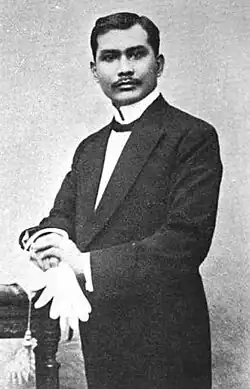Macario Adriatico
Macario Adriático | |
|---|---|
 Adriático as a member of the Philippine Assembly, 1908 | |
| Director of the Philippine Library and Museum | |
| In office July 1917 – April 14, 1919 | |
| Preceded by | Feliciano Basa |
| Succeeded by | Enrique V. Filamor |
| Member of the Philippine Assembly from Mindoro's lone district | |
| In office October 16, 1907 – March 1, 1914 | |
| Preceded by | District established |
| Succeeded by | Mariano P. Leuterio |
| Personal details | |
| Born | March 10, 1869 Calapan, Mindoro, Captaincy General of the Philippines |
| Died | April 14, 1919 (aged 50) Santa Mesa, Manila, Philippine Islands |
| Political party | Nacionalista |
| Spouse | Paula Lazaro |
| Parents |
|
| Education | |
| Occupation |
|
| Writing career | |
| Language | Spanish |
Macario Adriático y Gonzáles (March 10, 1869 – April 14, 1919) was a Filipino lawyer, journalist and politician from Mindoro. He was credited for the creation of the city charter of Manila.[1]
Early life and education
Macario Adriatico was born in Calapan, Mindoro. His parents were Luciano Adriatico, a government official, and Natalia Gonzales.[2]
After completing his primary education in Mindoro, Adriatico was sent to Manila in 1882 for further studies. He entered the schools of Hipolito Magsalin and Enrique Mendiola.[3]
In 1889, he earned a degree in Bachelor of Arts from San Juan de Letran College. He pursued medicine studies at University of Santo Tomas, but later changed to law. He was married to Paula Lazaro.[2]
Career
Military career
Adriatico participated during the Philippine Revolution against Spain. In 1898, he helped the revolutionary forces from Batangas sent by Emilio Aguinaldo to defeat the Spanish troops in Calapan, Mindoro. He also organized an expeditionary force that liberated Romblon.[4]
During the Philippine-American War, he served as comandante de estado mayor or staff commander for the Philippine forces in Panay from 1899 to 1901.[5]
Journalism career
Adriatico began his writing career with La Moda Filipina. He also directed the political newspapers El Diario de Filipinas and La Independencia.[6] At the time of entering politics in 1907, Adriatico was a journalist and law professor.[7]
Political career
From 1907 to 1914, he served as assemblyman from Mindoro from the first to third Philippine legislatures during the American occupation in the country.[8] As a politician, Adriatico authored the city charter of Manila.[1] He resigned during his third term in 1914, when he was appointed member of the Code Committee.
Later career
From 1917 to 1919, Adriatico was designated as the first Filipino director of the Philippine Library and Museum.[2][9]
Death and recognition

Adriatico died on April 14, 1919, in Manila. In 1933, Calapan Central School was renamed Adriatico Memorial School in his honor,[10] and in 1964, Dakota Street in Manila was renamed after him.[1] A barangay in Gloria, Oriental Mindoro is also named after him.
References
- ^ a b c "BALIK-TANAW: Sino si Adriatico na ipinangalan sa isang kalye sa Maynila". GMA Network (in Filipino). Balitambayan. Retrieved 2024-03-31.
- ^ a b c "Adriatico, Macario". CulturEd: Philippine Cultural Education Online. Retrieved 2024-03-31.
- ^ Zaide, Gregorio F. (1970). Great Filipinos in History: An Epic of Filipino Greatness in War and Peace. Verde Book Store.
- ^ Chuaunsu, Jewel (January 20, 2014). "Meet Your Streets". spot.ph. Retrieved March 31, 2024.
- ^ Assembly, Philippines Legislature Philippine (1908). Official Directory (in Spanish). Bureau of Printing.
- ^ Artigas y Cuerva, Manuel (1917). Galeria de filipinos ilustres.
- ^ Album histórico de la primera Asamblea Filipina (in Spanish). 1908.
- ^ Official Directory of the House of Representatives. Quezon City: Capitol Publishing House. 1967.
- ^ "HISTORY OF THE NATIONAL LIBRARY". Philipine Pavilion. Retrieved June 21, 2025.
- ^ Act No. 4098 (November 29, 1933), An Act Changing the Name of Calapan Central School, Province of Mindoro, to That of Adriatico Memorial School, retrieved June 21, 2025